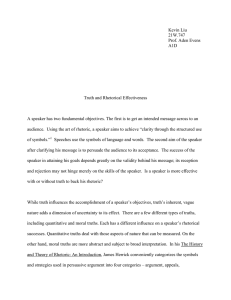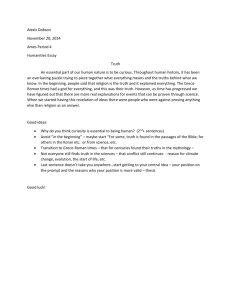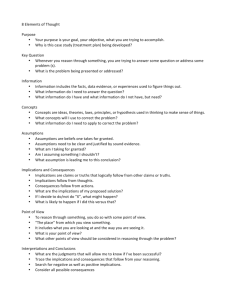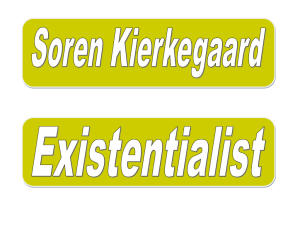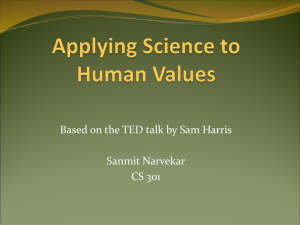Kevin Liu 21W.747
advertisement
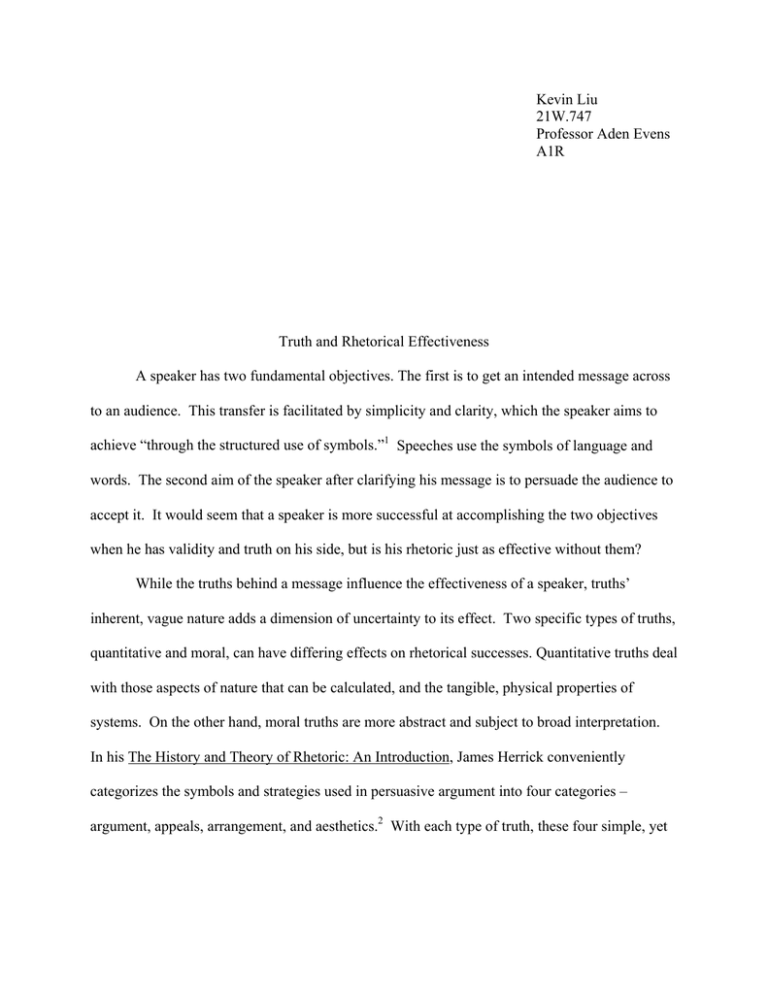
Kevin Liu 21W.747 Professor Aden Evens A1R Truth and Rhetorical Effectiveness A speaker has two fundamental objectives. The first is to get an intended message across to an audience. This transfer is facilitated by simplicity and clarity, which the speaker aims to achieve “through the structured use of symbols.”1 Speeches use the symbols of language and words. The second aim of the speaker after clarifying his message is to persuade the audience to accept it. It would seem that a speaker is more successful at accomplishing the two objectives when he has validity and truth on his side, but is his rhetoric just as effective without them? While the truths behind a message influence the effectiveness of a speaker, truths’ inherent, vague nature adds a dimension of uncertainty to its effect. Two specific types of truths, quantitative and moral, can have differing effects on rhetorical successes. Quantitative truths deal with those aspects of nature that can be calculated, and the tangible, physical properties of systems. On the other hand, moral truths are more abstract and subject to broad interpretation. In his The History and Theory of Rhetoric: An Introduction, James Herrick conveniently categorizes the symbols and strategies used in persuasive argument into four categories – argument, appeals, arrangement, and aesthetics.2 With each type of truth, these four simple, yet very prevalent methods of persuasion offer different angles and dimensions from which to approach the truth’s influence on a speaker’s rhetoric. The seemingly uncomplicated nature of quantitative truths would suggest that its relationship with rhetorical success is the most straightforward of the ones aforementioned. A quantitative truth’s “measurable” aspect implies that some form of experimentation was done to obtain the results the truth claims. How certain chemicals react with each other is found through thorough laboratory work; the nature of our solar system has been extensively mapped by space probes. A chemistry professor can clarify her work to her students through visual means. She can take them to the lab, combust magnesium with oxygen, and show students the extremely bright light that results. In another case, an astronomer can easily prove the spherical shape of the Earth today. He only has to pull up satellite images and point to the curvature displayed. Yet, that last truth, which we take for granted nowadays, was not taken so lightly just a few hundred years ago. Before the Scientific Revolution of the 17th century, Aristotle showed through valid scientific methods that the Earth was at the center of the solar system. Parallax states that “relative positions of distant fixed objects shift for a moving observer.” Classical astronomers convinced themselves and others that because the stars did not shift positions in the sky, the Earth must have been at the center.3 A fact that we know today to be false had convinced all the brightest intellectuals of the time of its “truth” through scientific arguments. People are readily persuaded by qualitative truths. The sway of moral truths over a rhetor’s effects, however, can be less concrete. The concept of morality is debated in many circles and illustrations of what is or is not moral vary greatly. Moral truths, in its general form, can be understood to refer to those principles that are ethical and right; principles that are accepted by a society who seeks to treat all its citizens with -2- respect and fairness. A morality issue that has been repeatedly challenged in the past 100 years is human rights and justice. Has history given us advocates and opponents of this issue who were equally successful in spreading their message? The greatest war ever fought between nations produced two of the greatest orators, Winston Churchill and Adolf Hitler. Throughout World War II, Churchill advocated principles that are ethical and right; he endeavored to expand a society that sought to treat all its citizens with respect and fairness. By these standards, Hitler did the exact opposite. He schemed to spread wealth to only a very specific and minute portion of the German people, and pushed forward institutionalized genocide with secret police and concentration camps. However, both used their skills of rhetoric to rally populations behind them and advance their agendas. In one of history’s most moving and passionate speeches, Winston Churchill addressed the House of Commons to rally the British people in anticipation of the Battle of Britain, “We shall not flag nor fail. We shall go on to the end. We shall fight in France and on the seas and oceans; we shall fight with growing confidence and growing strength in the air. We shall defend our island whatever the cost may be; we shall fight on beaches, landing grounds, in fields, in streets and on the hills. We shall never surrender…”4 Aesthetically, he arranges this passage at the end of his speech giving the country’s status update to sum up his clear intention to never give up. Churchill displays his resolve and commitment with lines of repetition. In this particular speech, he argues for the strength of the British Fleet and her people. He appeals to their patriotism to brace them for the oncoming Nazi assault, and in the end, he is successful in every way. -3- In his lifetime, Adolf Hitler rose to power in Nazi Germany by appealing to the hatred and bitterness harbored by the suppressed Germans. His skillful rhetoric argued for and placed the blame for their defeat in World War I onto the Jewish population, first in Germany, then the world. In the following excerpt, his demonstrates his blatant manipulation of language to promote genocide, “For us, this is not a problem you can turn a blind eye to-one to be solved by small concessions. For us, it is a problem of whether our nation can ever recover its health, whether the Jewish spirit can ever really be eradicated. Don't be misled into thinking you can fight a disease without killing the carrier, without destroying the bacillus. Don't think you can fight racial tuberculosis without taking care to rid the nation of the carrier of that racial tuberculosis. This Jewish contamination will not subside, this poisoning of the nation will not end, until the carrier himself, the Jew, has been banished from our midst.”5 By comparing the Jews to bacteria infesting a human body, he appeals to the German people’s sense of personal safety and natural tendency to want to wipe out foreign pathogens. He evokes a sense of fear with repeated uses of the word “carrier” and successfully uses word choice to drive home his message of disgust for the Jewish people. In the case of qualitative truths, rhetoric is absolutely influenced by it. People will need evidence and science when being persuaded of what they are told are “facts.” Although the rhetoric needs “truth”, the “truth” itself doesn’t necessarily need reality. The physical properties can be misinterpreted and used to lead the audience to a false understanding of the world around them. However, in the case of morality, both the supporter and detractor of the truth (as accepted by a civilized society), are successful in clarifying their objectives and then persuading their audience. The type of truth affects the success of the rhetoric. A speaker’s success is -4- determined by the truth when that truth can be measured and shown. A speaker’s skill, however, is the deciding factor in his efficiency and success in matters of moral concern. 1 Herrick, James A. The History and Theory of Rhetoric: An Introduction, 2nd Ed.. Needham Heights, MA: Ally & Bacon, 2001. 2 Herrick, James A. The History and Theory of Rhetoric: An Introduction, 2nd Ed.. Needham Heights, MA: Ally & Bacon, 2001. 3 McDermot, Dennis. PC 106 - Physical Science: Chapter 1: The Scientific Process. Lake Erie College, Painesville, Ohio. Available: www.lec.edu/facstaff/dmcdermot/ Physical%20Science/Chapter%201.doc. 4 Department of History, Hanover College. Available: http://history.hanover.edu/courses/excerpts/111chur.html. 5 University of the West of England. Available: http://www.ess.uwe.ac.uk/genocide/statements.htm. -5- Kevin, Your essay argues that different kinds of truths have different sorts of influence over rhetoric, and call for different approaches by the rhetor. This revision demonstrates an admirable clarity, both in the mechanics of your prose and in the overall shape of your argument. Your points flow logically from one to the next without redundancy and without becoming simply a list of evidence. You provide rich and evocative examples to illustrate your claims, which succeeds both in piquing your reader’s interest and in further clarifying and specifying your claims. Indeed, the strength of the essay rests on the value of your examples, and these examples hold up well under the weight of this argument. I have primarily two criticisms aimed at further improvement of this revision. The first and less important criticism is that the thesis statement could have been placed in the first paragraph in an imperative tone. The question that ends the first paragraph is not really the focus of the essay, and it would have been more informative to the reader to put your thesis there, namely, that quantitative truths play a role in rhetoric that relates to facts and indisputables, while moral truths leave more room for the skill of the rhetor. If this is your point, there is no reason not to state it up front. The second criticism is more general and more important. You should do more to bring out the complexity of your topic. It isn’t especially hard to accept the basic claim you make, that moral truths are more arguable than quantitative ones. You do go considerably beyond this basic claim in some key respects. For instance, you show that quantitative truths change over time, casting their solidness into doubt. You also complicate your analysis by showing moral debate in action, using quotes to demonstrate the ways in which moral truths can be pushed around to different effects. But these complexities could have gone still further. Just how malleable are quantitative truths? If they can change over time, what happens at the borders of those changes, how does rhetoric, normally subordinate to quantitative truth, somehow get hold of such a truth and alter it? Are the differences between quantitative truth and moral truth absolute, or is there a kind of middle ground or overlap? And how much latitude is there in moral truth? Can one make a convincing claim for any moral stance or are there limits? And if there are limits, where do they come from? Was it Churchill’s and Hitler’s rhetorical abilities that made them so successful, or was something else necessary for their arguments to work, something already at work in the audience to whom they were speaking? The point is not that you failed to answer one or more of these questions. The point is rather that the subject matter itself is of great import and extreme complexity. Rather than manifesting this complexity for your reader, you tie it into a neat bundle and draw a rather tame conclusion. For next time, stick out your neck a bit farther. Try to write about things that you don’t fully understand, or write at the very limits of your understanding. That’s where things get most interesting. 3.2 out of 4

